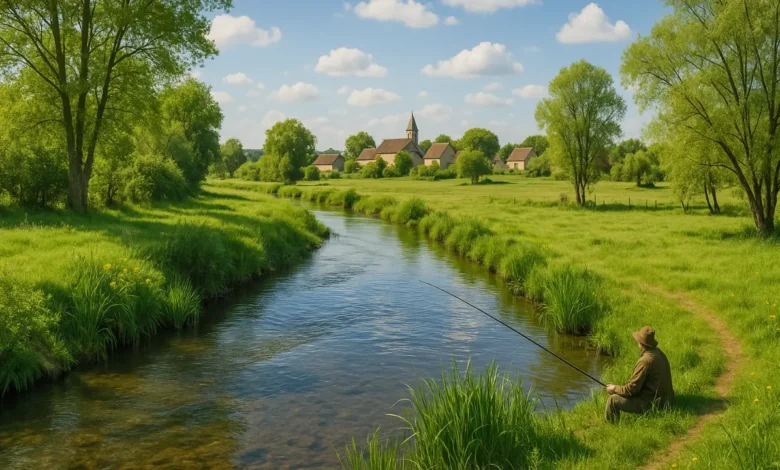Discovering Ruisseau d’Avenelle: An Ecological Gem in Loiret, France

Nestled within the serene landscapes of the Loiret department in central France, the Ruisseau d’Avenelle offers a remarkable glimpse into the quiet yet dynamic life of French rural waterways. Flowing gently towards its confluence with the majestic Loire River near Beaulieu-sur-Loire, this small stream embodies both the tranquility and ecological importance of France’s lesser-known waterways.
Geographical Overview
The Ruisseau d’Avenelle originates from modest, idyllic rural areas characterized by gently rolling hills and agricultural lands. Its course threads gracefully through the picturesque countryside, encompassing villages and hamlets such as Pierrefitte and Moulin Fleury. This stream eventually merges with the Loire River, one of France’s most significant watercourses, contributing to the vast hydrographic network of the Loire basin.
Historical Significance
The name “Avenelle” derives from historical roots common in medieval France. Linked to the medieval surname Avenel, which was widely known in both France and England, this stream reflects centuries of historical and cultural evolution. Early cartographic documents refer to the watercourse under various similar names, highlighting its long-standing significance to both residents and historians.
Ecology and Biodiversity
The ecological value of the Ruisseau d’Avenelle is substantial. This seemingly modest stream plays a crucial role in supporting regional biodiversity. It provides habitats for a variety of aquatic species, including fish like carp, perch, chub, and tench, as well as smaller amphibians and invertebrates. The surrounding banks and riparian zones create diverse ecological niches that support rich local flora and fauna.
Flora and Fauna
The banks of the Ruisseau d’Avenelle host an assortment of vegetation typical of central France’s waterways, such as alder trees, willows, and reeds. These plants not only prevent erosion but also offer essential habitats for birds and insects. The lush banks serve as vital nesting grounds for a variety of avian species, rendering it a substantial spot for birdwatchers.
Aquatic life flourishes within the clear waters of the Ruisseau d’Avenelle. Fish populations thrive, supported by ample food resources and relatively clean water conditions, although occasional environmental stresses due to agricultural runoff have raised local concerns.
Challenges and Conservation
Despite its natural beauty, the Ruisseau d’Avenelle faces environmental pressures every day in rural watercourses in agricultural regions. Runoff from farmlands, occasional untreated effluents, and lack of consistent maintenance pose threats to the ecological health of the stream. Local environmental groups and authorities are increasingly involved in efforts to monitor, manage, and restore the health of this vital waterway.
Conservation initiatives often include community-driven projects that aim to improve water quality, such as planting riparian buffers, monitoring water quality, and adopting sustainable agricultural practices. These efforts help mitigate the adverse impacts of human activities, ensuring that the stream continues to support the diverse life forms dependent on its waters.
Recreational Opportunities
The ecological diversity and natural splendor of the Ruisseau d’Avenelle attract locals and visitors alike, offering a range of leisure activities that are in harmony with the surrounding environment. Fishing enthusiasts regularly frequent the area, enjoying the challenge of catching local fish species while appreciating the peacefulness of the setting.
In addition to fishing, the trails and paths lining the banks of the stream invite visitors to engage in hiking, birdwatching, and nature photography. This region’s tranquil ambiance makes it particularly appealing for leisurely walks and contemplative moments amid nature.
Scenic Picnic Areas
Several designated picnic areas near the Ruisseau d’Avenelle provide idyllic spots for families and visitors to unwind and appreciate the majesty of the landscape. These areas offer basic facilities and are strategically placed to maximize scenic views and accessibility, enhancing the recreational appeal of the region.
Importance to Local Communities
The Ruisseau d’Avenelle serves not only ecological and recreational objectives but also makes a substantial contribution to the cultural and economic fabric of nearby communities. Watercourses like this often underpin local identities and traditions, fostering a sense of pride and belonging among inhabitants.
Events such as community clean-up days, educational field trips, and ecological workshops frequently revolve around the stream, fostering community cohesion and raising environmental awareness. By engaging locals directly in stewardship activities, the significance of preserving the stream for future generations becomes deeply rooted in community values.
Hydrological Contributions
As a tributary of the Loire, the Ruisseau d’Avenelle plays an essential role in the region’s hydrological dynamics. Its contribution to the overall water volume, despite being modest compared to larger rivers, is vital in maintaining regional groundwater levels and supporting agricultural irrigation needs.
The hydrological connectivity between smaller tributaries and larger river systems, such as the Loire, is critical for maintaining ecological balance. Such interconnected systems ensure adequate water distribution and support extensive ecosystems far beyond their immediate environments.
Educational Potential
The Ruisseau d’Avenelle also presents a valuable educational resource. Local schools and ecological organizations frequently utilize the stream as a living laboratory, educating students and community members about ecology, conservation, and sustainability. Hands-on experiences, such as water testing and biodiversity surveys, provide impactful lessons about environmental stewardship and the delicate balance within natural ecosystems.
Future Prospects and Sustainability
Looking forward, the sustainable management of the Ruisseau d’Avenelle depends heavily on continued community involvement, rigorous scientific monitoring, and effective environmental policies. As rural regions face pressures from climate change, agricultural intensification, and urbanization, proactive strategies become paramount.
Collaborative initiatives involving local authorities, community groups, and conservation organizations are crucial for ensuring that the stream remains ecologically vibrant and beneficial to the community. Ongoing efforts to improve agricultural practices, enhance riparian buffers, and maintain clean water conditions will shape the future health and vitality of this cherished local waterway.
Conclusion
The Ruisseau d’Avenelle, though modest in size, holds significant ecological, recreational, and cultural value within the Loiret region. By appreciating its historical roots, environmental richness, and community importance, we recognize the broader value of preserving small watercourses throughout France and beyond. The collective efforts of local communities and conservationists will determine the sustainability of such invaluable natural resources, ensuring their continued vitality for generations to come.
You May Also Read: Nova Vila Tamaro: A Hidden Gem for Nature, Culture, and Adventure Lovers




